Financial Management: Importance, Financial Statements and Ratios
VerifiedAdded on 2023/06/14
|16
|2613
|382
Report
AI Summary
This report provides a comprehensive overview of financial management, emphasizing its critical role in organizational success through profit maximization and cost minimization. It details the core concepts of financial management, including financial planning, fund acquisition, and sound financial decision-making, highlighting their impact on firm value. The report also examines key financial statements—the balance sheet, income statement, and cash flow statement—and their significance in assessing a company's financial health. Furthermore, it discusses the application of ratio analysis in interpreting financial data, understanding profitability, and evaluating operational efficiency. The appendices provide practical examples of financial statements and ratio calculations. The report concludes by offering recommendations for improving financial performance, such as engaging qualified professionals, managing debt, and controlling costs, reinforcing the importance of effective financial management in achieving business objectives. Desklib provides a platform to access similar solved assignments.

Importance of
Financial
Management
Financial
Management
Paraphrase This Document
Need a fresh take? Get an instant paraphrase of this document with our AI Paraphraser
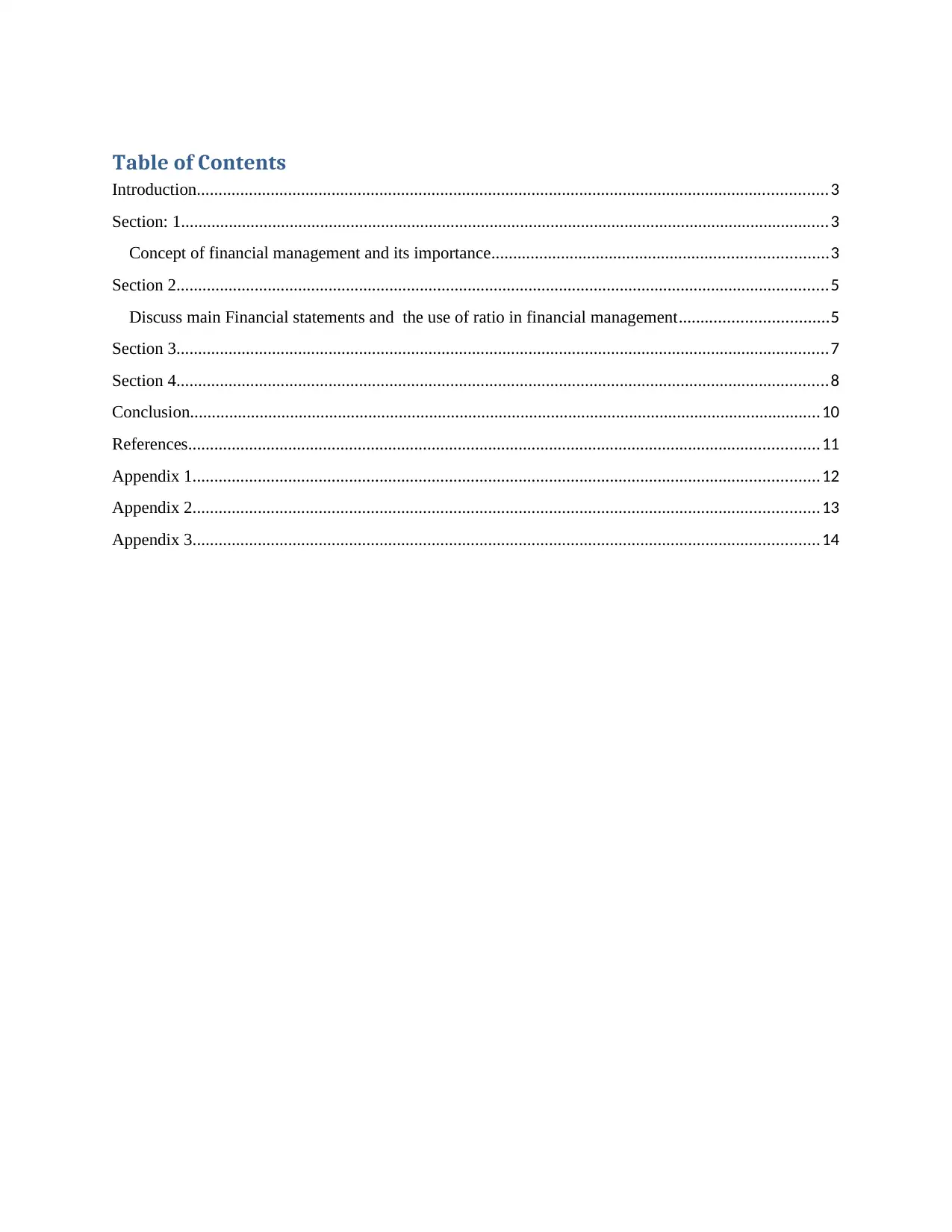
Table of Contents
Introduction.................................................................................................................................................3
Section: 1.....................................................................................................................................................3
Concept of financial management and its importance.............................................................................3
Section 2......................................................................................................................................................5
Discuss main Financial statements and the use of ratio in financial management..................................5
Section 3......................................................................................................................................................7
Section 4......................................................................................................................................................8
Conclusion.................................................................................................................................................10
References.................................................................................................................................................11
Appendix 1................................................................................................................................................12
Appendix 2................................................................................................................................................13
Appendix 3................................................................................................................................................14
Introduction.................................................................................................................................................3
Section: 1.....................................................................................................................................................3
Concept of financial management and its importance.............................................................................3
Section 2......................................................................................................................................................5
Discuss main Financial statements and the use of ratio in financial management..................................5
Section 3......................................................................................................................................................7
Section 4......................................................................................................................................................8
Conclusion.................................................................................................................................................10
References.................................................................................................................................................11
Appendix 1................................................................................................................................................12
Appendix 2................................................................................................................................................13
Appendix 3................................................................................................................................................14
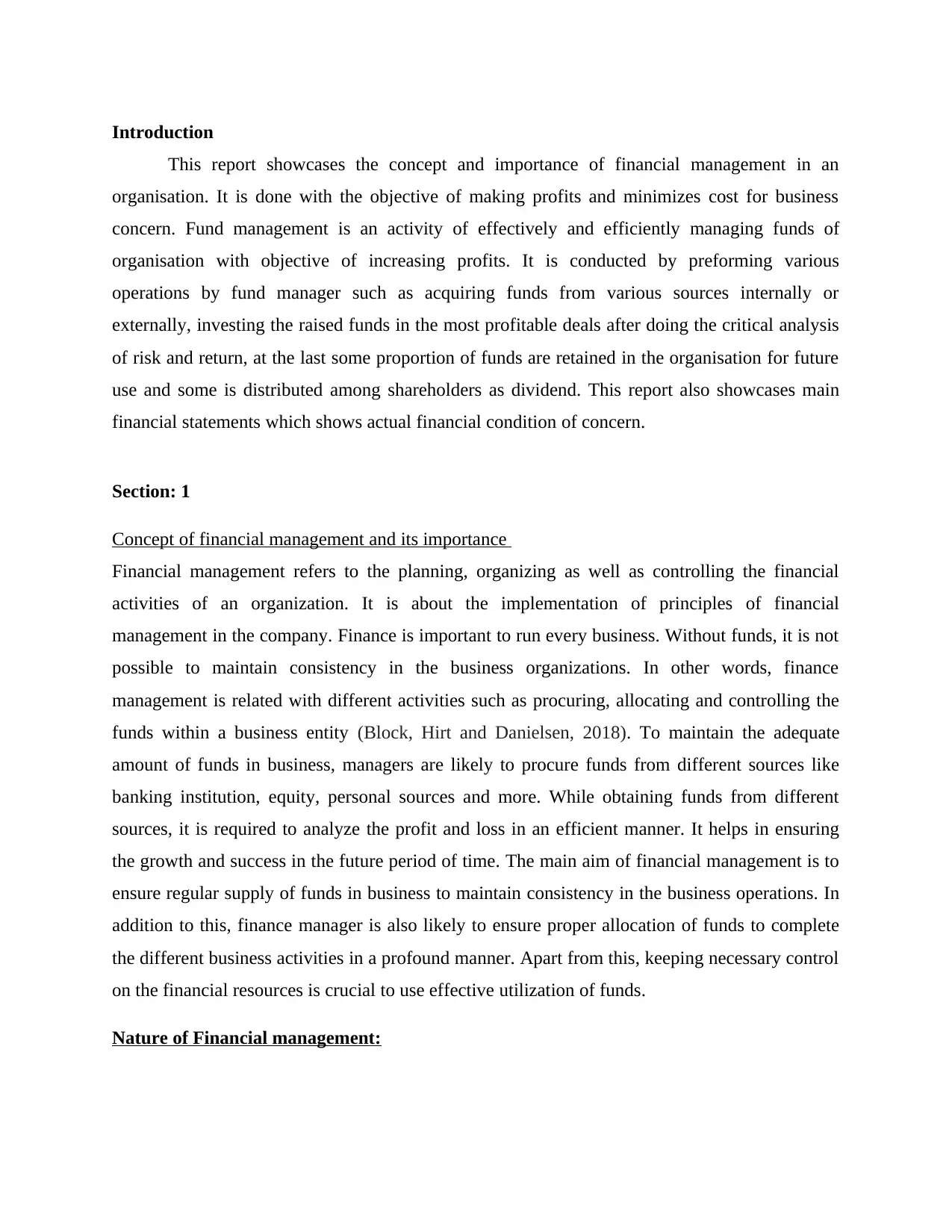
Introduction
This report showcases the concept and importance of financial management in an
organisation. It is done with the objective of making profits and minimizes cost for business
concern. Fund management is an activity of effectively and efficiently managing funds of
organisation with objective of increasing profits. It is conducted by preforming various
operations by fund manager such as acquiring funds from various sources internally or
externally, investing the raised funds in the most profitable deals after doing the critical analysis
of risk and return, at the last some proportion of funds are retained in the organisation for future
use and some is distributed among shareholders as dividend. This report also showcases main
financial statements which shows actual financial condition of concern.
Section: 1
Concept of financial management and its importance
Financial management refers to the planning, organizing as well as controlling the financial
activities of an organization. It is about the implementation of principles of financial
management in the company. Finance is important to run every business. Without funds, it is not
possible to maintain consistency in the business organizations. In other words, finance
management is related with different activities such as procuring, allocating and controlling the
funds within a business entity (Block, Hirt and Danielsen, 2018). To maintain the adequate
amount of funds in business, managers are likely to procure funds from different sources like
banking institution, equity, personal sources and more. While obtaining funds from different
sources, it is required to analyze the profit and loss in an efficient manner. It helps in ensuring
the growth and success in the future period of time. The main aim of financial management is to
ensure regular supply of funds in business to maintain consistency in the business operations. In
addition to this, finance manager is also likely to ensure proper allocation of funds to complete
the different business activities in a profound manner. Apart from this, keeping necessary control
on the financial resources is crucial to use effective utilization of funds.
Nature of Financial management:
This report showcases the concept and importance of financial management in an
organisation. It is done with the objective of making profits and minimizes cost for business
concern. Fund management is an activity of effectively and efficiently managing funds of
organisation with objective of increasing profits. It is conducted by preforming various
operations by fund manager such as acquiring funds from various sources internally or
externally, investing the raised funds in the most profitable deals after doing the critical analysis
of risk and return, at the last some proportion of funds are retained in the organisation for future
use and some is distributed among shareholders as dividend. This report also showcases main
financial statements which shows actual financial condition of concern.
Section: 1
Concept of financial management and its importance
Financial management refers to the planning, organizing as well as controlling the financial
activities of an organization. It is about the implementation of principles of financial
management in the company. Finance is important to run every business. Without funds, it is not
possible to maintain consistency in the business organizations. In other words, finance
management is related with different activities such as procuring, allocating and controlling the
funds within a business entity (Block, Hirt and Danielsen, 2018). To maintain the adequate
amount of funds in business, managers are likely to procure funds from different sources like
banking institution, equity, personal sources and more. While obtaining funds from different
sources, it is required to analyze the profit and loss in an efficient manner. It helps in ensuring
the growth and success in the future period of time. The main aim of financial management is to
ensure regular supply of funds in business to maintain consistency in the business operations. In
addition to this, finance manager is also likely to ensure proper allocation of funds to complete
the different business activities in a profound manner. Apart from this, keeping necessary control
on the financial resources is crucial to use effective utilization of funds.
Nature of Financial management:
⊘ This is a preview!⊘
Do you want full access?
Subscribe today to unlock all pages.

Trusted by 1+ million students worldwide
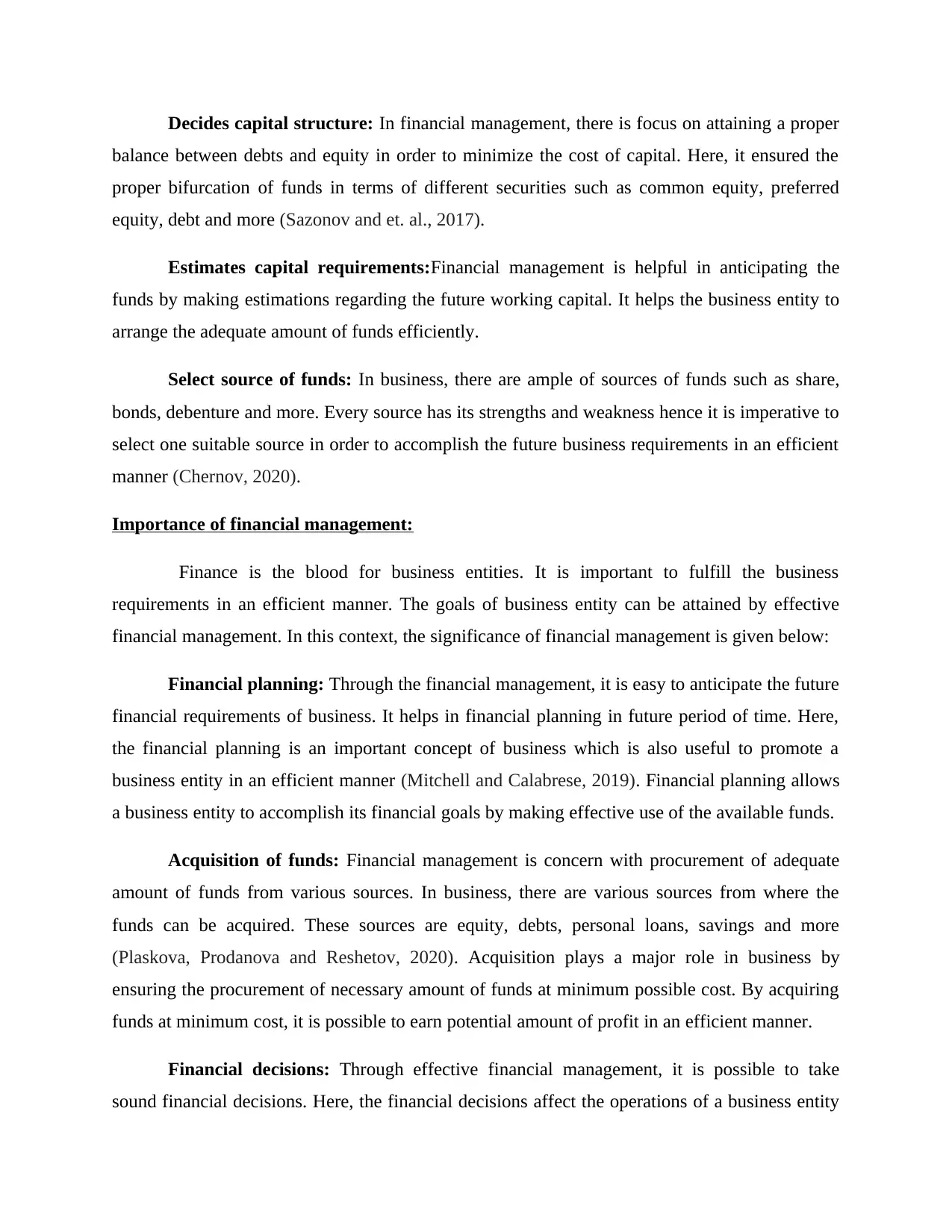
Decides capital structure: In financial management, there is focus on attaining a proper
balance between debts and equity in order to minimize the cost of capital. Here, it ensured the
proper bifurcation of funds in terms of different securities such as common equity, preferred
equity, debt and more (Sazonov and et. al., 2017).
Estimates capital requirements:Financial management is helpful in anticipating the
funds by making estimations regarding the future working capital. It helps the business entity to
arrange the adequate amount of funds efficiently.
Select source of funds: In business, there are ample of sources of funds such as share,
bonds, debenture and more. Every source has its strengths and weakness hence it is imperative to
select one suitable source in order to accomplish the future business requirements in an efficient
manner (Chernov, 2020).
Importance of financial management:
Finance is the blood for business entities. It is important to fulfill the business
requirements in an efficient manner. The goals of business entity can be attained by effective
financial management. In this context, the significance of financial management is given below:
Financial planning: Through the financial management, it is easy to anticipate the future
financial requirements of business. It helps in financial planning in future period of time. Here,
the financial planning is an important concept of business which is also useful to promote a
business entity in an efficient manner (Mitchell and Calabrese, 2019). Financial planning allows
a business entity to accomplish its financial goals by making effective use of the available funds.
Acquisition of funds: Financial management is concern with procurement of adequate
amount of funds from various sources. In business, there are various sources from where the
funds can be acquired. These sources are equity, debts, personal loans, savings and more
(Plaskova, Prodanova and Reshetov, 2020). Acquisition plays a major role in business by
ensuring the procurement of necessary amount of funds at minimum possible cost. By acquiring
funds at minimum cost, it is possible to earn potential amount of profit in an efficient manner.
Financial decisions: Through effective financial management, it is possible to take
sound financial decisions. Here, the financial decisions affect the operations of a business entity
balance between debts and equity in order to minimize the cost of capital. Here, it ensured the
proper bifurcation of funds in terms of different securities such as common equity, preferred
equity, debt and more (Sazonov and et. al., 2017).
Estimates capital requirements:Financial management is helpful in anticipating the
funds by making estimations regarding the future working capital. It helps the business entity to
arrange the adequate amount of funds efficiently.
Select source of funds: In business, there are ample of sources of funds such as share,
bonds, debenture and more. Every source has its strengths and weakness hence it is imperative to
select one suitable source in order to accomplish the future business requirements in an efficient
manner (Chernov, 2020).
Importance of financial management:
Finance is the blood for business entities. It is important to fulfill the business
requirements in an efficient manner. The goals of business entity can be attained by effective
financial management. In this context, the significance of financial management is given below:
Financial planning: Through the financial management, it is easy to anticipate the future
financial requirements of business. It helps in financial planning in future period of time. Here,
the financial planning is an important concept of business which is also useful to promote a
business entity in an efficient manner (Mitchell and Calabrese, 2019). Financial planning allows
a business entity to accomplish its financial goals by making effective use of the available funds.
Acquisition of funds: Financial management is concern with procurement of adequate
amount of funds from various sources. In business, there are various sources from where the
funds can be acquired. These sources are equity, debts, personal loans, savings and more
(Plaskova, Prodanova and Reshetov, 2020). Acquisition plays a major role in business by
ensuring the procurement of necessary amount of funds at minimum possible cost. By acquiring
funds at minimum cost, it is possible to earn potential amount of profit in an efficient manner.
Financial decisions: Through effective financial management, it is possible to take
sound financial decisions. Here, the financial decisions affect the operations of a business entity
Paraphrase This Document
Need a fresh take? Get an instant paraphrase of this document with our AI Paraphraser
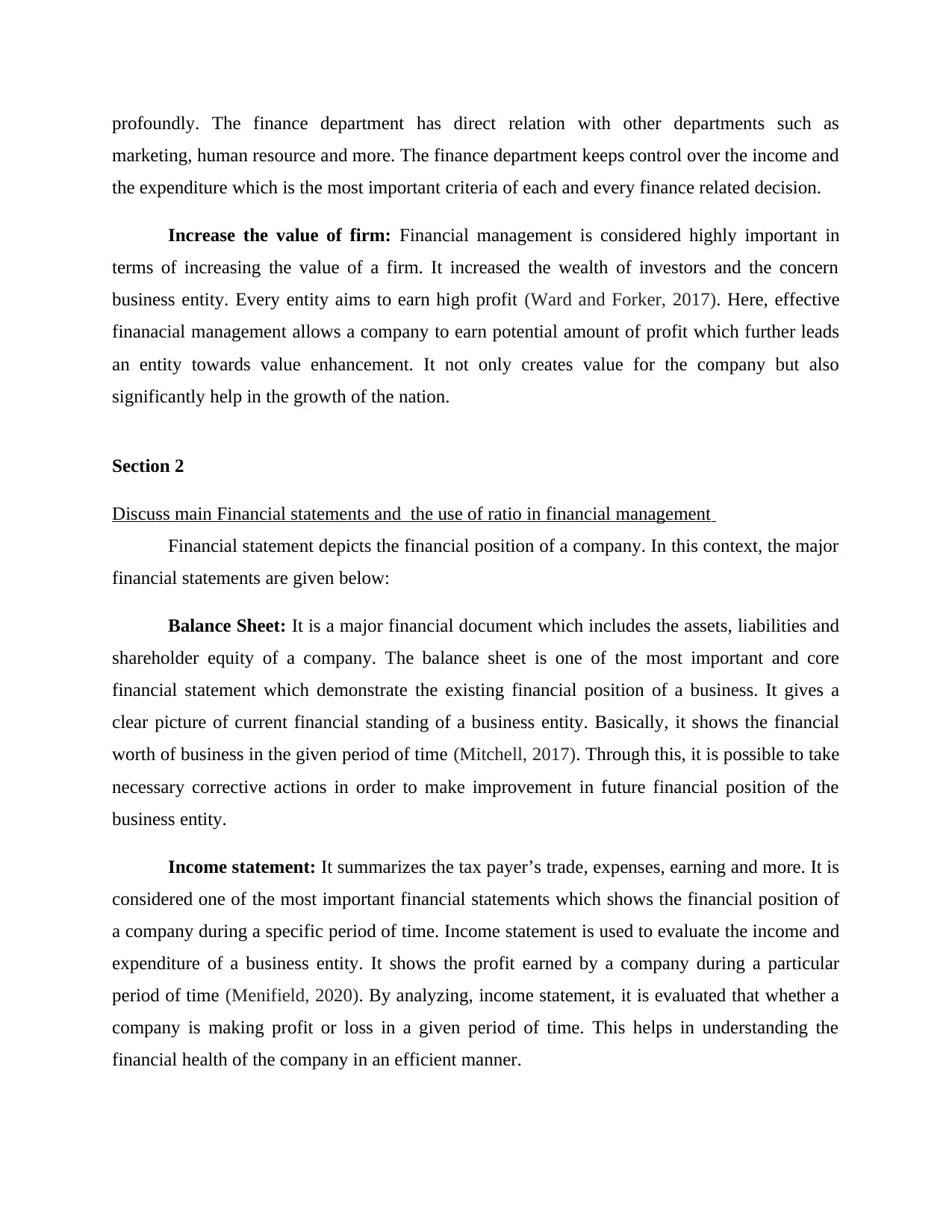
profoundly. The finance department has direct relation with other departments such as
marketing, human resource and more. The finance department keeps control over the income and
the expenditure which is the most important criteria of each and every finance related decision.
Increase the value of firm: Financial management is considered highly important in
terms of increasing the value of a firm. It increased the wealth of investors and the concern
business entity. Every entity aims to earn high profit (Ward and Forker, 2017). Here, effective
finanacial management allows a company to earn potential amount of profit which further leads
an entity towards value enhancement. It not only creates value for the company but also
significantly help in the growth of the nation.
Section 2
Discuss main Financial statements and the use of ratio in financial management
Financial statement depicts the financial position of a company. In this context, the major
financial statements are given below:
Balance Sheet: It is a major financial document which includes the assets, liabilities and
shareholder equity of a company. The balance sheet is one of the most important and core
financial statement which demonstrate the existing financial position of a business. It gives a
clear picture of current financial standing of a business entity. Basically, it shows the financial
worth of business in the given period of time (Mitchell, 2017). Through this, it is possible to take
necessary corrective actions in order to make improvement in future financial position of the
business entity.
Income statement: It summarizes the tax payer’s trade, expenses, earning and more. It is
considered one of the most important financial statements which shows the financial position of
a company during a specific period of time. Income statement is used to evaluate the income and
expenditure of a business entity. It shows the profit earned by a company during a particular
period of time (Menifield, 2020). By analyzing, income statement, it is evaluated that whether a
company is making profit or loss in a given period of time. This helps in understanding the
financial health of the company in an efficient manner.
marketing, human resource and more. The finance department keeps control over the income and
the expenditure which is the most important criteria of each and every finance related decision.
Increase the value of firm: Financial management is considered highly important in
terms of increasing the value of a firm. It increased the wealth of investors and the concern
business entity. Every entity aims to earn high profit (Ward and Forker, 2017). Here, effective
finanacial management allows a company to earn potential amount of profit which further leads
an entity towards value enhancement. It not only creates value for the company but also
significantly help in the growth of the nation.
Section 2
Discuss main Financial statements and the use of ratio in financial management
Financial statement depicts the financial position of a company. In this context, the major
financial statements are given below:
Balance Sheet: It is a major financial document which includes the assets, liabilities and
shareholder equity of a company. The balance sheet is one of the most important and core
financial statement which demonstrate the existing financial position of a business. It gives a
clear picture of current financial standing of a business entity. Basically, it shows the financial
worth of business in the given period of time (Mitchell, 2017). Through this, it is possible to take
necessary corrective actions in order to make improvement in future financial position of the
business entity.
Income statement: It summarizes the tax payer’s trade, expenses, earning and more. It is
considered one of the most important financial statements which shows the financial position of
a company during a specific period of time. Income statement is used to evaluate the income and
expenditure of a business entity. It shows the profit earned by a company during a particular
period of time (Menifield, 2020). By analyzing, income statement, it is evaluated that whether a
company is making profit or loss in a given period of time. This helps in understanding the
financial health of the company in an efficient manner.
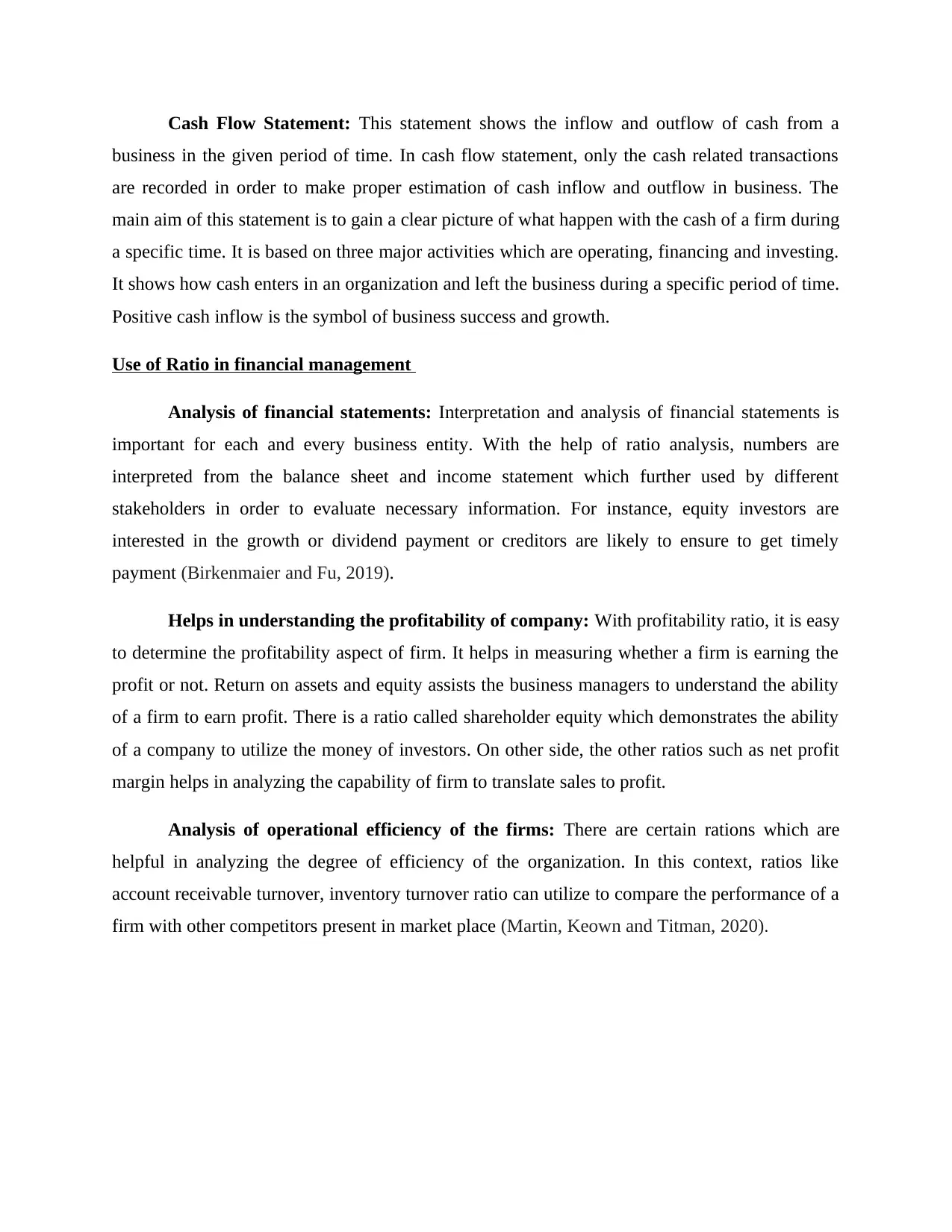
Cash Flow Statement: This statement shows the inflow and outflow of cash from a
business in the given period of time. In cash flow statement, only the cash related transactions
are recorded in order to make proper estimation of cash inflow and outflow in business. The
main aim of this statement is to gain a clear picture of what happen with the cash of a firm during
a specific time. It is based on three major activities which are operating, financing and investing.
It shows how cash enters in an organization and left the business during a specific period of time.
Positive cash inflow is the symbol of business success and growth.
Use of Ratio in financial management
Analysis of financial statements: Interpretation and analysis of financial statements is
important for each and every business entity. With the help of ratio analysis, numbers are
interpreted from the balance sheet and income statement which further used by different
stakeholders in order to evaluate necessary information. For instance, equity investors are
interested in the growth or dividend payment or creditors are likely to ensure to get timely
payment (Birkenmaier and Fu, 2019).
Helps in understanding the profitability of company: With profitability ratio, it is easy
to determine the profitability aspect of firm. It helps in measuring whether a firm is earning the
profit or not. Return on assets and equity assists the business managers to understand the ability
of a firm to earn profit. There is a ratio called shareholder equity which demonstrates the ability
of a company to utilize the money of investors. On other side, the other ratios such as net profit
margin helps in analyzing the capability of firm to translate sales to profit.
Analysis of operational efficiency of the firms: There are certain rations which are
helpful in analyzing the degree of efficiency of the organization. In this context, ratios like
account receivable turnover, inventory turnover ratio can utilize to compare the performance of a
firm with other competitors present in market place (Martin, Keown and Titman, 2020).
business in the given period of time. In cash flow statement, only the cash related transactions
are recorded in order to make proper estimation of cash inflow and outflow in business. The
main aim of this statement is to gain a clear picture of what happen with the cash of a firm during
a specific time. It is based on three major activities which are operating, financing and investing.
It shows how cash enters in an organization and left the business during a specific period of time.
Positive cash inflow is the symbol of business success and growth.
Use of Ratio in financial management
Analysis of financial statements: Interpretation and analysis of financial statements is
important for each and every business entity. With the help of ratio analysis, numbers are
interpreted from the balance sheet and income statement which further used by different
stakeholders in order to evaluate necessary information. For instance, equity investors are
interested in the growth or dividend payment or creditors are likely to ensure to get timely
payment (Birkenmaier and Fu, 2019).
Helps in understanding the profitability of company: With profitability ratio, it is easy
to determine the profitability aspect of firm. It helps in measuring whether a firm is earning the
profit or not. Return on assets and equity assists the business managers to understand the ability
of a firm to earn profit. There is a ratio called shareholder equity which demonstrates the ability
of a company to utilize the money of investors. On other side, the other ratios such as net profit
margin helps in analyzing the capability of firm to translate sales to profit.
Analysis of operational efficiency of the firms: There are certain rations which are
helpful in analyzing the degree of efficiency of the organization. In this context, ratios like
account receivable turnover, inventory turnover ratio can utilize to compare the performance of a
firm with other competitors present in market place (Martin, Keown and Titman, 2020).
⊘ This is a preview!⊘
Do you want full access?
Subscribe today to unlock all pages.

Trusted by 1+ million students worldwide
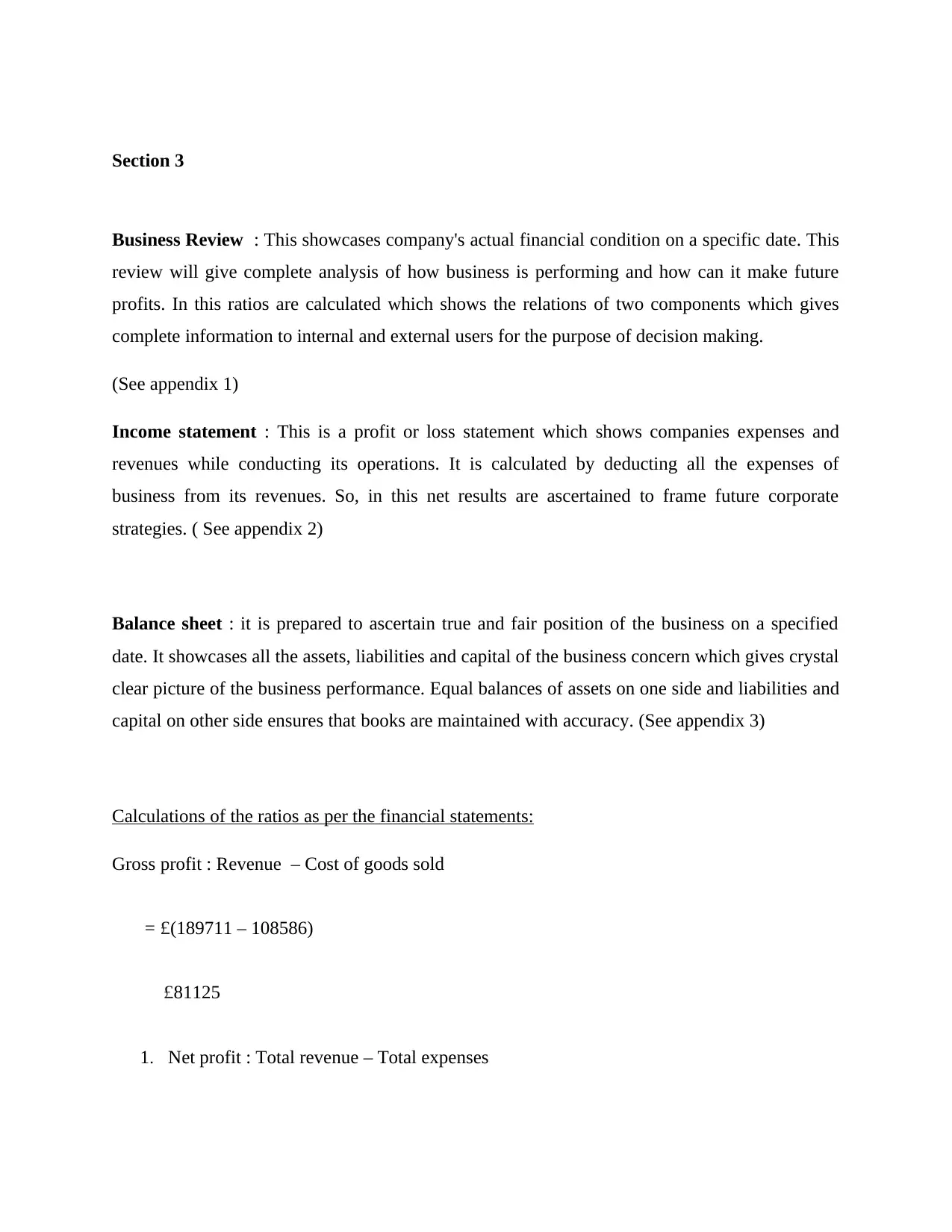
Section 3
Business Review : This showcases company's actual financial condition on a specific date. This
review will give complete analysis of how business is performing and how can it make future
profits. In this ratios are calculated which shows the relations of two components which gives
complete information to internal and external users for the purpose of decision making.
(See appendix 1)
Income statement : This is a profit or loss statement which shows companies expenses and
revenues while conducting its operations. It is calculated by deducting all the expenses of
business from its revenues. So, in this net results are ascertained to frame future corporate
strategies. ( See appendix 2)
Balance sheet : it is prepared to ascertain true and fair position of the business on a specified
date. It showcases all the assets, liabilities and capital of the business concern which gives crystal
clear picture of the business performance. Equal balances of assets on one side and liabilities and
capital on other side ensures that books are maintained with accuracy. (See appendix 3)
Calculations of the ratios as per the financial statements:
Gross profit : Revenue – Cost of goods sold
= £(189711 – 108586)
£81125
1. Net profit : Total revenue – Total expenses
Business Review : This showcases company's actual financial condition on a specific date. This
review will give complete analysis of how business is performing and how can it make future
profits. In this ratios are calculated which shows the relations of two components which gives
complete information to internal and external users for the purpose of decision making.
(See appendix 1)
Income statement : This is a profit or loss statement which shows companies expenses and
revenues while conducting its operations. It is calculated by deducting all the expenses of
business from its revenues. So, in this net results are ascertained to frame future corporate
strategies. ( See appendix 2)
Balance sheet : it is prepared to ascertain true and fair position of the business on a specified
date. It showcases all the assets, liabilities and capital of the business concern which gives crystal
clear picture of the business performance. Equal balances of assets on one side and liabilities and
capital on other side ensures that books are maintained with accuracy. (See appendix 3)
Calculations of the ratios as per the financial statements:
Gross profit : Revenue – Cost of goods sold
= £(189711 – 108586)
£81125
1. Net profit : Total revenue – Total expenses
Paraphrase This Document
Need a fresh take? Get an instant paraphrase of this document with our AI Paraphraser
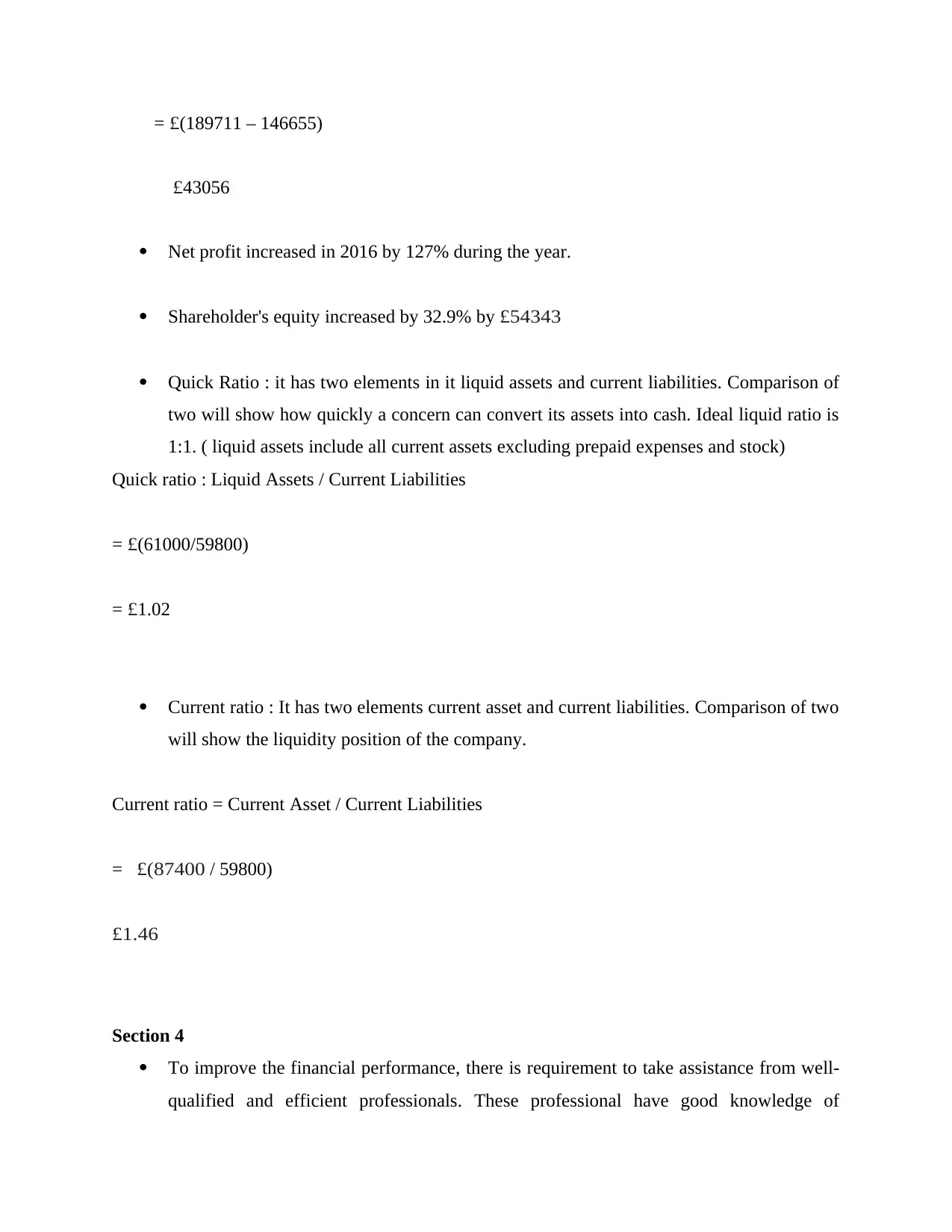
= £(189711 – 146655)
£43056
Net profit increased in 2016 by 127% during the year.
Shareholder's equity increased by 32.9% by £54343
Quick Ratio : it has two elements in it liquid assets and current liabilities. Comparison of
two will show how quickly a concern can convert its assets into cash. Ideal liquid ratio is
1:1. ( liquid assets include all current assets excluding prepaid expenses and stock)
Quick ratio : Liquid Assets / Current Liabilities
= £(61000/59800)
= £1.02
Current ratio : It has two elements current asset and current liabilities. Comparison of two
will show the liquidity position of the company.
Current ratio = Current Asset / Current Liabilities
= £(87400 / 59800)
£1.46
Section 4
To improve the financial performance, there is requirement to take assistance from well-
qualified and efficient professionals. These professional have good knowledge of
£43056
Net profit increased in 2016 by 127% during the year.
Shareholder's equity increased by 32.9% by £54343
Quick Ratio : it has two elements in it liquid assets and current liabilities. Comparison of
two will show how quickly a concern can convert its assets into cash. Ideal liquid ratio is
1:1. ( liquid assets include all current assets excluding prepaid expenses and stock)
Quick ratio : Liquid Assets / Current Liabilities
= £(61000/59800)
= £1.02
Current ratio : It has two elements current asset and current liabilities. Comparison of two
will show the liquidity position of the company.
Current ratio = Current Asset / Current Liabilities
= £(87400 / 59800)
£1.46
Section 4
To improve the financial performance, there is requirement to take assistance from well-
qualified and efficient professionals. These professional have good knowledge of
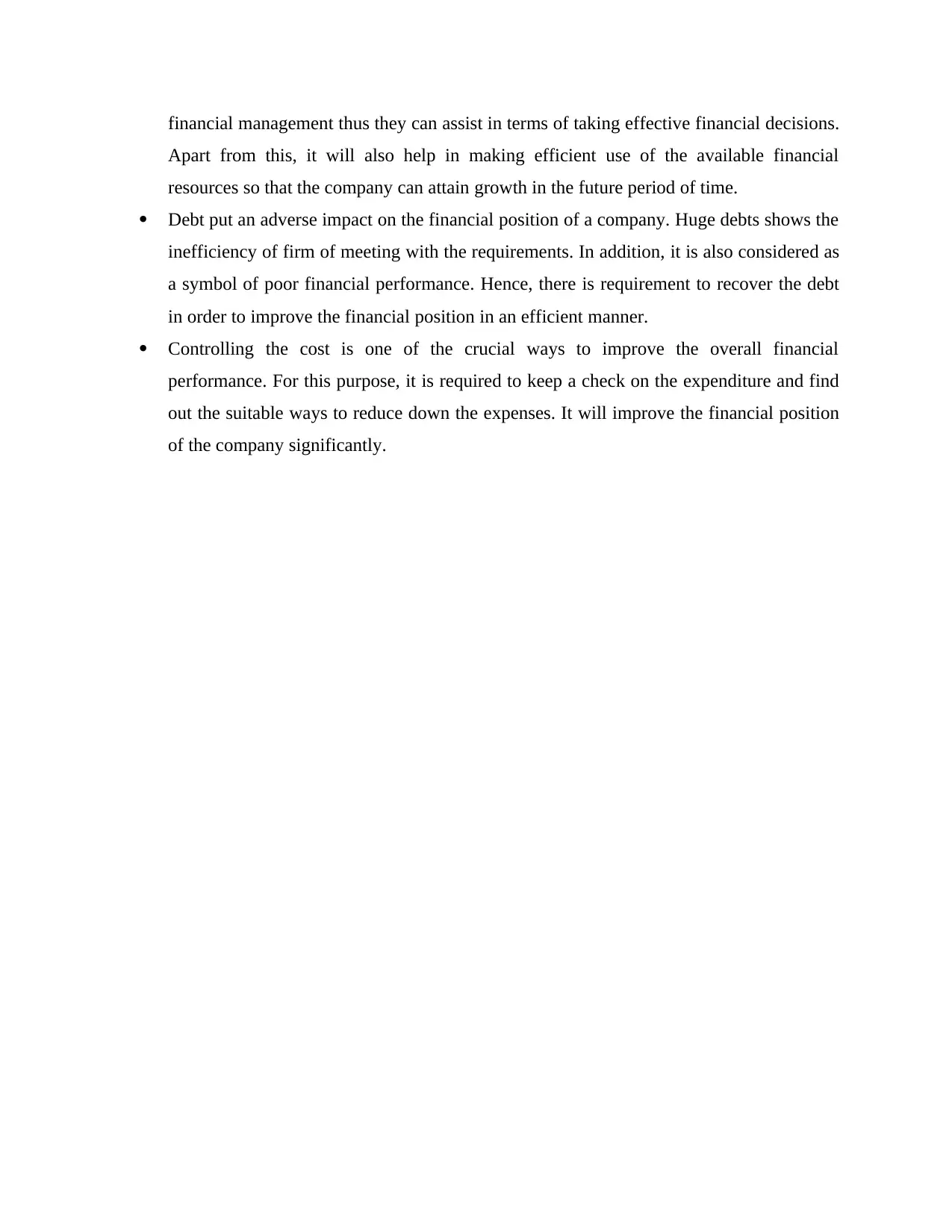
financial management thus they can assist in terms of taking effective financial decisions.
Apart from this, it will also help in making efficient use of the available financial
resources so that the company can attain growth in the future period of time.
Debt put an adverse impact on the financial position of a company. Huge debts shows the
inefficiency of firm of meeting with the requirements. In addition, it is also considered as
a symbol of poor financial performance. Hence, there is requirement to recover the debt
in order to improve the financial position in an efficient manner.
Controlling the cost is one of the crucial ways to improve the overall financial
performance. For this purpose, it is required to keep a check on the expenditure and find
out the suitable ways to reduce down the expenses. It will improve the financial position
of the company significantly.
Apart from this, it will also help in making efficient use of the available financial
resources so that the company can attain growth in the future period of time.
Debt put an adverse impact on the financial position of a company. Huge debts shows the
inefficiency of firm of meeting with the requirements. In addition, it is also considered as
a symbol of poor financial performance. Hence, there is requirement to recover the debt
in order to improve the financial position in an efficient manner.
Controlling the cost is one of the crucial ways to improve the overall financial
performance. For this purpose, it is required to keep a check on the expenditure and find
out the suitable ways to reduce down the expenses. It will improve the financial position
of the company significantly.
⊘ This is a preview!⊘
Do you want full access?
Subscribe today to unlock all pages.

Trusted by 1+ million students worldwide
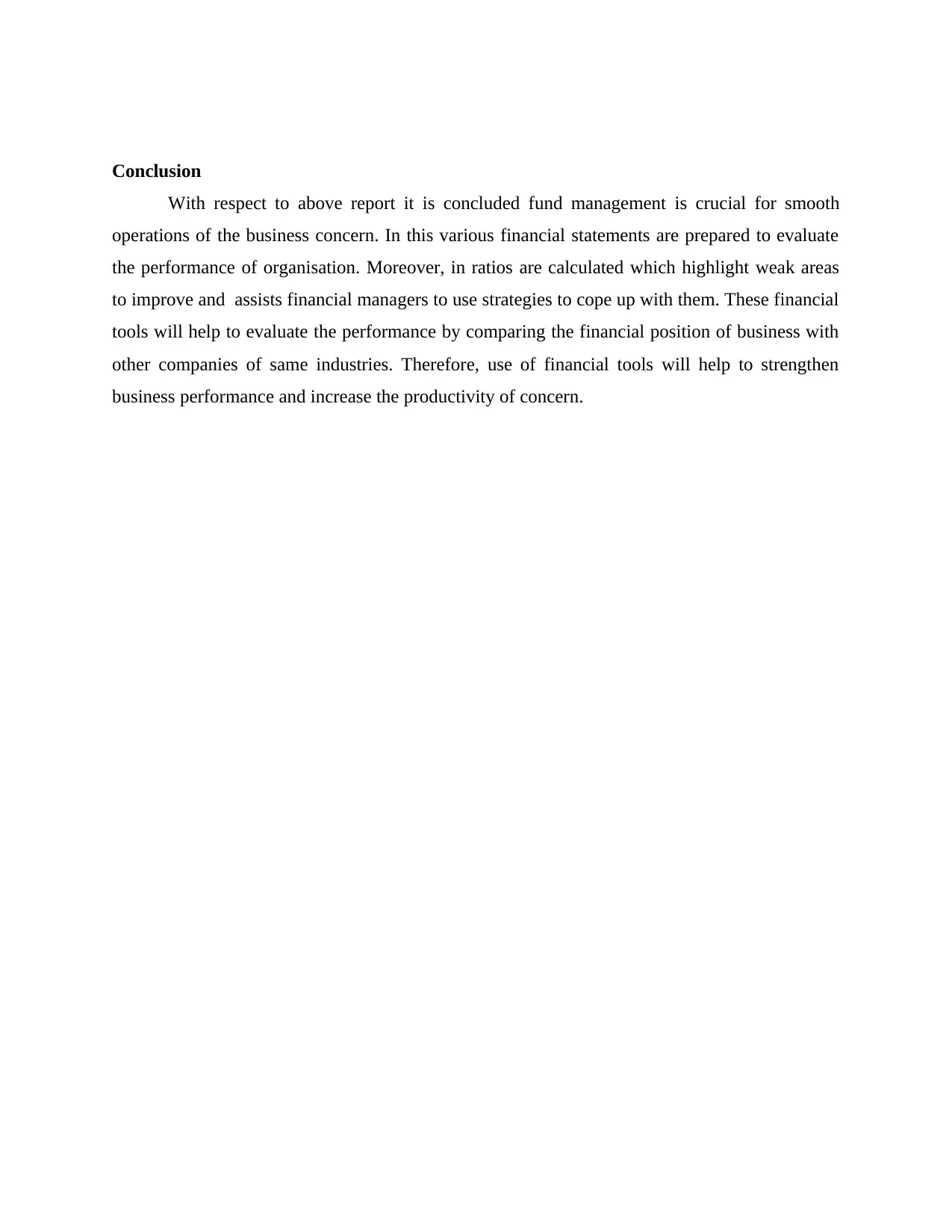
Conclusion
With respect to above report it is concluded fund management is crucial for smooth
operations of the business concern. In this various financial statements are prepared to evaluate
the performance of organisation. Moreover, in ratios are calculated which highlight weak areas
to improve and assists financial managers to use strategies to cope up with them. These financial
tools will help to evaluate the performance by comparing the financial position of business with
other companies of same industries. Therefore, use of financial tools will help to strengthen
business performance and increase the productivity of concern.
With respect to above report it is concluded fund management is crucial for smooth
operations of the business concern. In this various financial statements are prepared to evaluate
the performance of organisation. Moreover, in ratios are calculated which highlight weak areas
to improve and assists financial managers to use strategies to cope up with them. These financial
tools will help to evaluate the performance by comparing the financial position of business with
other companies of same industries. Therefore, use of financial tools will help to strengthen
business performance and increase the productivity of concern.
Paraphrase This Document
Need a fresh take? Get an instant paraphrase of this document with our AI Paraphraser
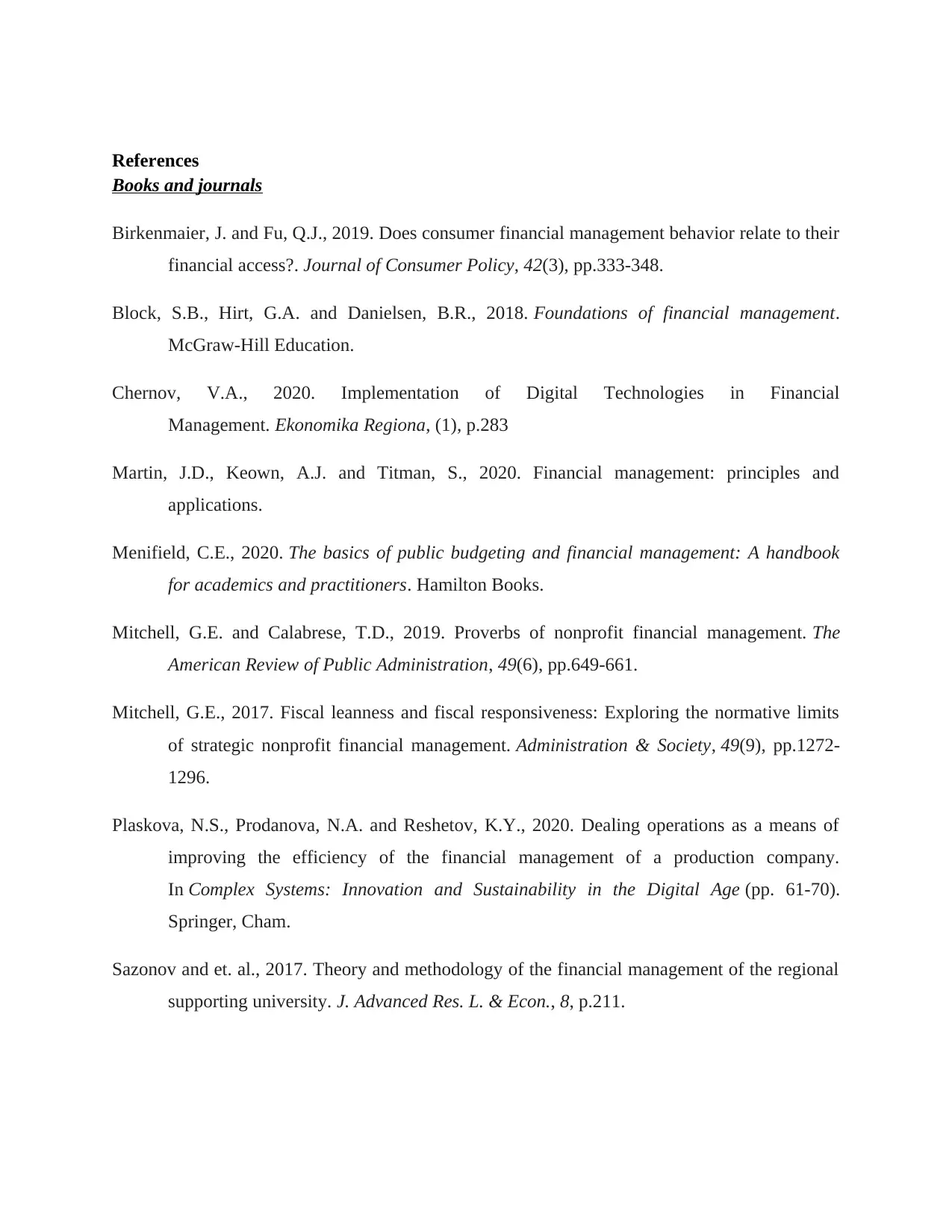
References
Books and journals
Birkenmaier, J. and Fu, Q.J., 2019. Does consumer financial management behavior relate to their
financial access?. Journal of Consumer Policy, 42(3), pp.333-348.
Block, S.B., Hirt, G.A. and Danielsen, B.R., 2018. Foundations of financial management.
McGraw-Hill Education.
Chernov, V.A., 2020. Implementation of Digital Technologies in Financial
Management. Ekonomika Regiona, (1), p.283
Martin, J.D., Keown, A.J. and Titman, S., 2020. Financial management: principles and
applications.
Menifield, C.E., 2020. The basics of public budgeting and financial management: A handbook
for academics and practitioners. Hamilton Books.
Mitchell, G.E. and Calabrese, T.D., 2019. Proverbs of nonprofit financial management. The
American Review of Public Administration, 49(6), pp.649-661.
Mitchell, G.E., 2017. Fiscal leanness and fiscal responsiveness: Exploring the normative limits
of strategic nonprofit financial management. Administration & Society, 49(9), pp.1272-
1296.
Plaskova, N.S., Prodanova, N.A. and Reshetov, K.Y., 2020. Dealing operations as a means of
improving the efficiency of the financial management of a production company.
In Complex Systems: Innovation and Sustainability in the Digital Age (pp. 61-70).
Springer, Cham.
Sazonov and et. al., 2017. Theory and methodology of the financial management of the regional
supporting university. J. Advanced Res. L. & Econ., 8, p.211.
Books and journals
Birkenmaier, J. and Fu, Q.J., 2019. Does consumer financial management behavior relate to their
financial access?. Journal of Consumer Policy, 42(3), pp.333-348.
Block, S.B., Hirt, G.A. and Danielsen, B.R., 2018. Foundations of financial management.
McGraw-Hill Education.
Chernov, V.A., 2020. Implementation of Digital Technologies in Financial
Management. Ekonomika Regiona, (1), p.283
Martin, J.D., Keown, A.J. and Titman, S., 2020. Financial management: principles and
applications.
Menifield, C.E., 2020. The basics of public budgeting and financial management: A handbook
for academics and practitioners. Hamilton Books.
Mitchell, G.E. and Calabrese, T.D., 2019. Proverbs of nonprofit financial management. The
American Review of Public Administration, 49(6), pp.649-661.
Mitchell, G.E., 2017. Fiscal leanness and fiscal responsiveness: Exploring the normative limits
of strategic nonprofit financial management. Administration & Society, 49(9), pp.1272-
1296.
Plaskova, N.S., Prodanova, N.A. and Reshetov, K.Y., 2020. Dealing operations as a means of
improving the efficiency of the financial management of a production company.
In Complex Systems: Innovation and Sustainability in the Digital Age (pp. 61-70).
Springer, Cham.
Sazonov and et. al., 2017. Theory and methodology of the financial management of the regional
supporting university. J. Advanced Res. L. & Econ., 8, p.211.

Ward, A.M. and Forker, J., 2017. Financial management effectiveness and board gender
diversity in member-governed, community financial institutions. Journal of business
ethics, 141(2), pp.351-366.
diversity in member-governed, community financial institutions. Journal of business
ethics, 141(2), pp.351-366.
⊘ This is a preview!⊘
Do you want full access?
Subscribe today to unlock all pages.

Trusted by 1+ million students worldwide
1 out of 16
Related Documents
Your All-in-One AI-Powered Toolkit for Academic Success.
+13062052269
info@desklib.com
Available 24*7 on WhatsApp / Email
![[object Object]](/_next/static/media/star-bottom.7253800d.svg)
Unlock your academic potential
Copyright © 2020–2025 A2Z Services. All Rights Reserved. Developed and managed by ZUCOL.




